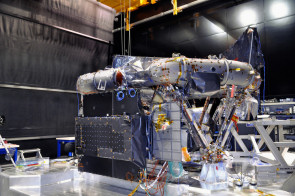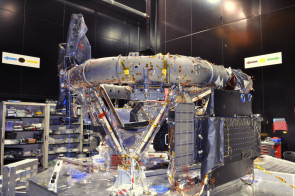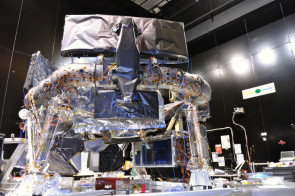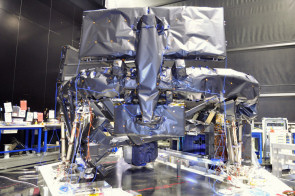#06: Gaia Payload Module integration completed
17 September 2012
Integration of the Flight Model of the Gaia Payload Module has been completed. It has undergone acceptance vibration testing; thermal balance and thermal vacuum testing will be carried out towards the end of this year.
 |
 |
|
Gaia Payload Module during integration. Credit: Astrium SAS |
|
The first article in this journal covered vibration testing of the Structural Model of the Gaia Payload Module (PLM). That test qualified the structural design and manufacture of the optical bench, or torus, but mass dummies represented some of the PLM components. The integration of the flight PLM has now been completed with the installation of remainder of the flight-model components: the mirrors for the second telescope, the Basic Angle Monitor (BAM - Journal article #03), the Radial Velocity Spectrometer (RVS) and the Focal Plane Assembly (FPA).
The integration of the PLM included careful alignment of the optical components. The recent vibration testing verified, amongst other things, that the alignments will remain within tolerance when the completed spacecraft is subjected to the dynamic mechanical environment of launch. The tests were carried out at Intespace Toulouse, as was the case with the PLM Structural Model qualification tests.
 |
 |
|
Gaia Payload Module during integration. Credit: Astrium SAS |
Gaia Payload Module with multi-layer insulation installed. Credit: Astrium SAS |
The images show the PLM as it approached completion, with the accelerometers needed for vibration testing and the temperature sensors for the thermal balance/thermal vacuum testing being installed, followed by the multi-layer insulation that protects the optical bench and mirrors from extraneous cold. In its full flight configuration, a thermal tent (TTS, not shown here) will cover the PLM.
About Gaia
Gaia will create a three-dimensional map of the Milky Way, in the process revealing information about its composition, formation and evolution. The mission will perform positional measurements for about one billion stars in our Galaxy and Local Group with unprecedented precision, together with radial velocity measurements for the brightest 150 million objects. Gaia is scheduled to launch in 2013 for a nominal five-year mission, with a possible one-year extension.
The spacecraft will operate in a Lissajous orbit around the second Lagrange point of the Sun-Earth system (L2). This location in space offers a very stable thermal environment, very high observing efficiency (since the Sun, Earth and Moon are all behind the instrument FoV) and a low radiation environment. Uninterrupted mapping of the sky will take place during the operational mission phase.
The Prime Contractor for Gaia is Astrium SAS, based in Toulouse, France.




